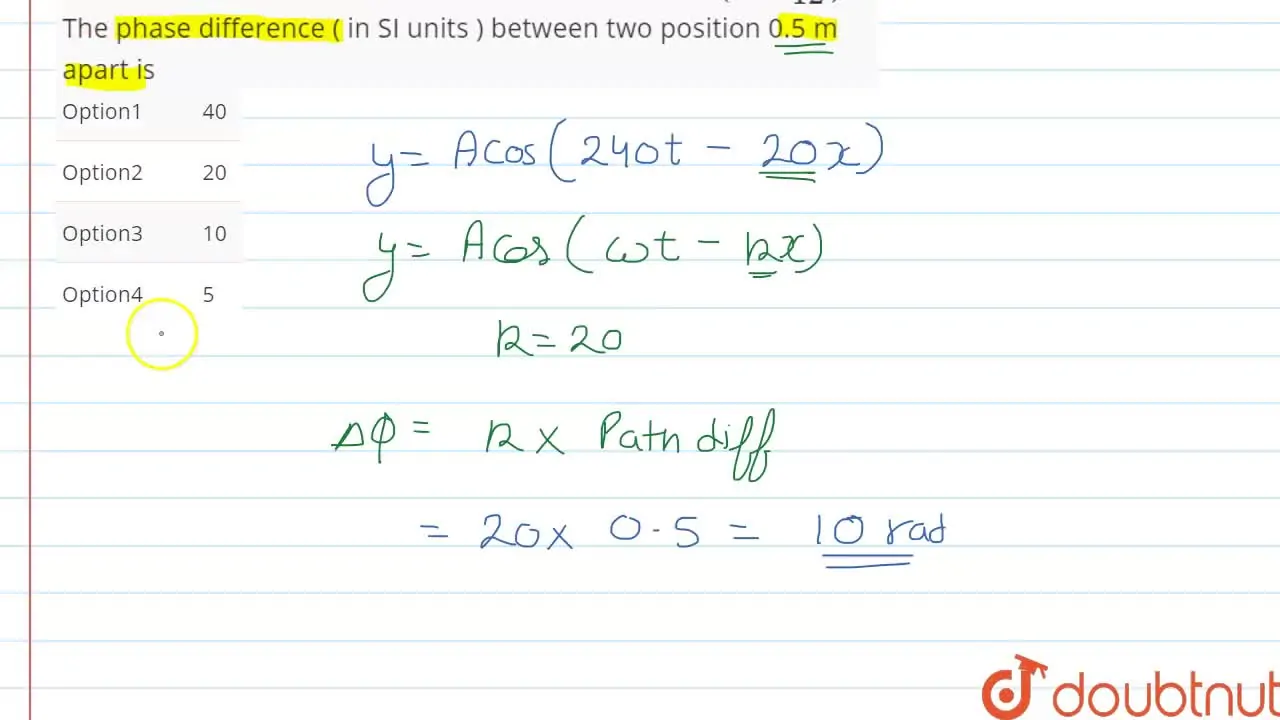The equation of the progressive wave, where t is the time in second , x is the distance in metre is y=Acos240(t−x12) . The phase difference ( in SI units ) between two position 0.5 m apart is
40
20
10
5
The correct Answer is:C
Step by step video & image solution for The equation of the progressive wave, where t is the time in second , x is the distance in metre is y= A cos 240 (t-(x)/(12)) . The phase difference ( in SI units ) between two position 0.5 m apart is by Physics experts to help you in doubts & scoring excellent marks in Class 12 exams.
Related Playlists
- BOOK - AAKASH INSTITUTE ENGLISHCHAPTER - WAVESEXERCISE - ASSIGNMENT ( SECTION-A ( Objective type Questions ))50videos
WAVES
- BOOK - AAKASH INSTITUTE ENGLISHCHAPTER - WAVESEXERCISE - ASSIGNMENT ( SECTION-B ( Objective type Questions ))45videos
WAVES
- BOOK - AAKASH INSTITUTE ENGLISHCHAPTER - WAVESEXERCISE - Assignment (Section-J) (Paragraph Type Questions)4videos
WAVES
- BOOK - AAKASH INSTITUTE ENGLISHCHAPTER - WAVE OPTICSEXERCISE - Assignment (Section-J (Aakash Challengers question))1videos
WAVE OPTICS
- BOOK - AAKASH INSTITUTE ENGLISHCHAPTER - WORK, ENERGY AND POWEREXERCISE - Assignment (SECTION - D)13videos
WORK, ENERGY AND POWER
Similar Questions
The equation of a progressive wave is give by y=0.20sin2π(60t−x/5) where x and y are in metres and t is in seconds. Find the phase difference (a) between two particles separted by a distance of Δx=125cm,and(b)betweenthetwo∈stants(1//120 s and 1//40 s, for any particle.
View SolutionThe equation of a simple harmonic progressive wave is given by y = A sin (100πt−3x) . Find the distance between 2 particles having a phase difference of π3.
View SolutionThe equation of a progressive wave is given by y=asin(628t−31.4x). If the distance are expressed in cms and time seconds, then the wave in this string wll be
View SolutionThe equation of a progressive wave is given by
y=asin(628t−31.4x)
If the distances are expressed in cms and time in seconds, then the wave velocity will beView SolutionThe position of a particle is given by
x=2(t−t2)
where t is expressed in seconds and x is in metre.
The particleView SolutionA simple harmonic progressive wave is representive by the equation y=8sin2π(0.1x−2t) where x and y are in centimetres and t is in seconds. At any instant the phase difference between two particle separted by 2.0 cm along the x-direction is
View SolutionThe equation of the progressive wave is y=3sin[π(t3−x5)+π4] , where x and y are in metre and time in second. Which of the following is correct.
View SolutionA plane progressive wave is given by y=3×10−7sin(8500t−25x), where t is in second y is in m. Find the amplitude, and phase difference between two points separated by a distance 0.01m.
View SolutionA simple harmonic progressive wave is represented by the equation- y = 8sin2π(0.1x — 2t) , where x and y are in cm and t is in second. At any instant the phase difference between two particles separated, by 2.0 cm in the x direction is
View SolutionThe equation below represents a progressive wave y=3×10−7sin(8500t−25x)
where t is in seconds x and y in metres. Calculate the speed of the wave and the direction of propagation.View Solution


